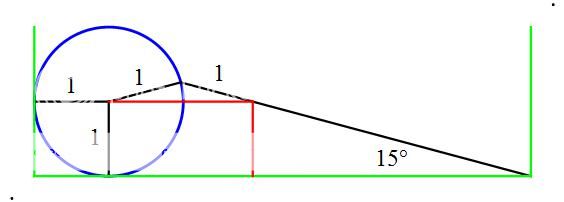Reflect on this...
A square A B C D of side length k contains unit circles at each of corners B and D such that each circle is tangent to the square at precisely two points. A ray of light emanating from point A reflects off each circle and then returns to A , creating a path in the shape of an equilateral triangle.
There is a unique value of k for which this scenario can occur. Find ⌊ 1 0 0 0 0 ⋅ k ⌋ .
Note: "Reflecting" means that the angle of incidence equals the angle of reflection.
The answer is 66639.
This section requires Javascript.
You are seeing this because something didn't load right. We suggest you, (a) try
refreshing the page, (b) enabling javascript if it is disabled on your browser and,
finally, (c)
loading the
non-javascript version of this page
. We're sorry about the hassle.
2 solutions
using trig we get k = (1 + sin 15°)/tan 15° + cos 15°+1 Is there some way I can add a figure? Describing this in just words will be pretty long winded :-(
Log in to reply
I understand how you feel; I've put off posting my solution because I don't know how to add a picture and, as the saying goes, a picture is worth a thousand words. :) I'm glad, though, that you were able to solve the problem; I was beginning to wonder if anyone would.
Log in to reply
To add a picture, upload it onto the internet and then use the markdown code of

I've added a screenshot of the video, so you can refer to the syntax.
Log in to reply
@Calvin Lin – Thank you Calvin! That really looks neat!
Thank you for that interesting problem Brian! I enjoyed solving it. Is it ok if I post the solution on my YouTube channel (https://www.youtube.com/user/UjjwalRane) and post the link to it here? By the way this reminded me of a similar problem with a 'find the shortest path' twist. I will post that on Brilliant. Thanks again :-)
Log in to reply
@Ujjwal Rane – Yes, of course. I look forward to seeing your solution. :)
Log in to reply
@Brian Charlesworth – It is up there now Please see (use full screen): https://www.youtube.com/watch?v=IUDJ9M3QZc8
Log in to reply
@Ujjwal Rane – That's great! The graphics and your explanation work so well together. Thanks for posting the video. :) I've made an edit to my 'solution' directing people to your video. I hope that it's o.k. that I did this; since they may not read all the comments they might not otherwise be aware of it.
Log in to reply
@Brian Charlesworth – The pleasure is all mine Brian! And kind of you to point to the video solution. Thank you!
Here's a graphic by which k can be computed through trigonometry
 Reflect on this
Reflect on this
From this we can see that
k = 1 + 2 C o s ( 1 5 ) + C o t ( 1 5 ) = 6 . 6 6 3 9 0 2 4 6 . . .
This is the same as Ujjwal's solution.
Log in to reply
Yup, that's it in a nutshell. :) falzoon's original problem was more general, whereby the triangle was isosceles with the angle at A being θ . So instead of 1 5 degrees we would be dealing with 2 9 0 − θ .
Log in to reply
Hello... M glad I solved this on first shot. Very nice problem!! But I solved it for equilateral triangle. And I am lazy enough to not solve it for general isosceles triangle. Can you please mention formula for general angle?
Log in to reply
@Pranjal Jain – Well, with θ as defined above, we would have
k = 1 + 2 cos ( 4 5 − 2 θ ) + cot ( 4 5 − 2 θ ) .
We could rewrite this in a number of ways, I suppose. My preferred way is
k = 1 + sec ( θ ) + tan ( θ ) + 2 + 2 sin ( θ ) .
Note that if the radii of the two circles is only specified as r then we would just scale k by the factor r .

The exact value for k is ( 2 1 ) ( 6 + 2 + 2 3 + 6 ) , which comes out to 6 . 6 6 3 9 0 2 5 . . . . Thus ⌊ 1 0 0 0 0 ∗ k ⌋ = 6 6 6 3 9 . Hopefully I'll have time this weekend to type out my solution method.
Edit: Please check out the excellent video solution posted by @Ujjwal Rane. My thanks to Ujjwal for posting this.
Screenshot at 5:06